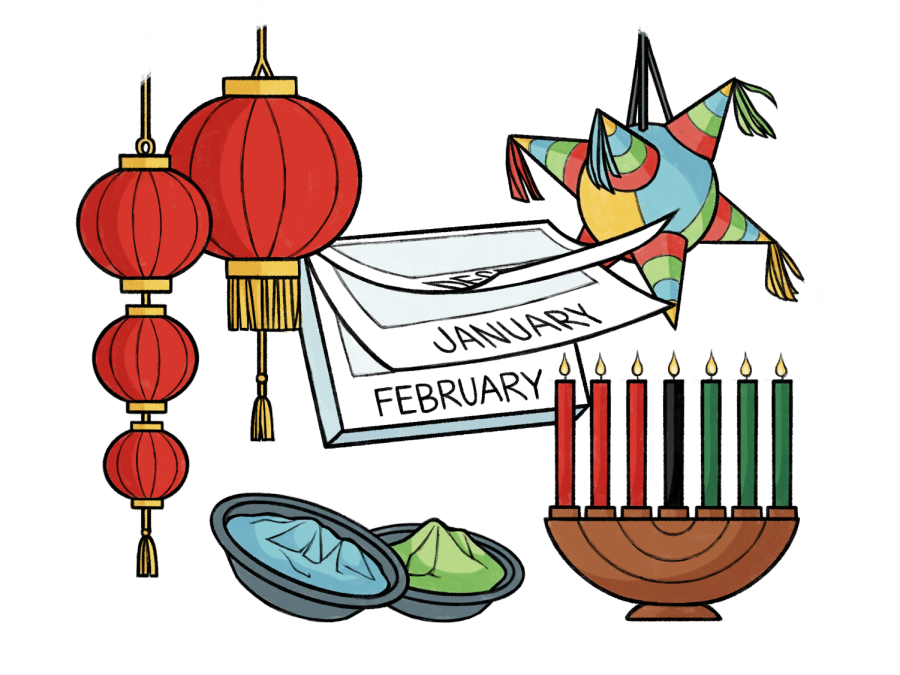FOCUS: American, Asian and Latine populations celebrate traditional customs and holidays
The population of SCHS is a diverse one, and many students and staff members celebrate holidays that are not traditionally observed in the United States. Ranging from the continent of Asia to the country of Mexico, there are many unique cultures that contain celebrations that occur in the winter and spring, ones with their own traditions, origins and values. The following are four different holidays that are not typically discussed.
Las Posadas, meaning “The Inns” in Spanish, memorializes the journey of Mary and Joseph in their search for shelter to give birth to Jesus Christ. Celebrated among Hispanic populations, the holiday occurs over nine nights from December 16 through 24, symbolizing the nine months Mary carried their child. Each night represents a different virtue: humility, strength, detachment, charity, trust, justice, purity, joy and generosity. In Mexico, festivities include people parading through the streets – often led by a child clothed as an angel – along with golden- and silver-robed children and a pictorial Mary and Joseph. They request passing residences for accommodations and are always refused in order to represent the declinations Mary and Joseph experienced. Other activities comprise reading scriptures, singing carols, attending mass and the popular tradition of breaking star-shaped piñatas.
Kwanzaa was created by California State University professor Dr. Maulana Karenga in 1966 for the purpose of reconnecting people of African descent to their culture. It takes place between December 26 and January 1, the seven days represented on the kinara, a candelabra of red, black and green candles. Each color symbolizes a value of the holiday: red for ancestral blood, black for the people, and green for the rich land and life of the African continent. Each day also holds a principle: umoja (unity), kujichagulia (self-determination), ujima (collective work and responsibility), ujamaa (cooperative economics), nia (purpose), kuumba (creativity) and imani (faith). Kwanzaa uses the Swahili language and means “first fruits,” relating to African harvest festivals. The celebrations feature cultural songs and dances alongside African drums. Storytelling and poetry make up evening traditions, and on the sixth day, families get together to attend Karamu, a traditional African feast.
2022’s Lunar New Year, with its annually-changing date, started on February 1 and lasts till the 11th. Also using the names Chinese New Year and Spring Festival, the holiday projects hope for a bountiful harvest, remembers the deceased and most prominently, hopes fortune upon oneself and their companions. Relatives and friends who have passed away are wished luck in the afterlife by burning incense and offering objects of importance. Families light firecrackers, make dumplings and decorate homes with red lanterns, string and paper-made ornaments. The color red is seen as lucky in east Asian tradition. Red envelopes filled with money are exchanged between friends along with the phrase, “gōng xǐ fā cái” or “gong hei fat choy” in Mandarin and Cantonese pinyin. They directly translate to, “Hope you get rich.” Many people also celebrate the Lantern Festival that occurs for four days after, often referred to as Asia’s equivalent to Valentine’s Day.
Celebrating the approach of spring is the Hindu holiday, Holi, dubbed “The Festival of Colors,” “Spring” or “Love.” It occurs on March 18 and is meant for commemorating fresh starts: the forgetting of resentments against one another, the leaving of barren winters, growing flora and blooming relationships. Mostly observed in India, the celebrations begin on Purnima, the night before the 18th, where a bonfire called Holika Dahan is lit to symbolize the persistent triumph of good over evil, originally derived from a mythological story of a battle of wit between gods. On the day of, communities gather together to celebrate the ideals of playfulness and love by throwing colored powder (gulal and abeer) and water balloons at each other. The streets are filled with children and adults, all participating in the activity, and in the evening, people exchange sweets and greetings to strengthen relationships.


